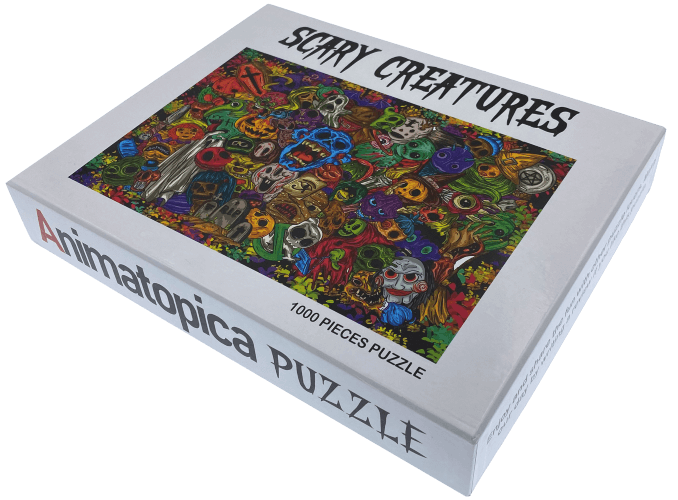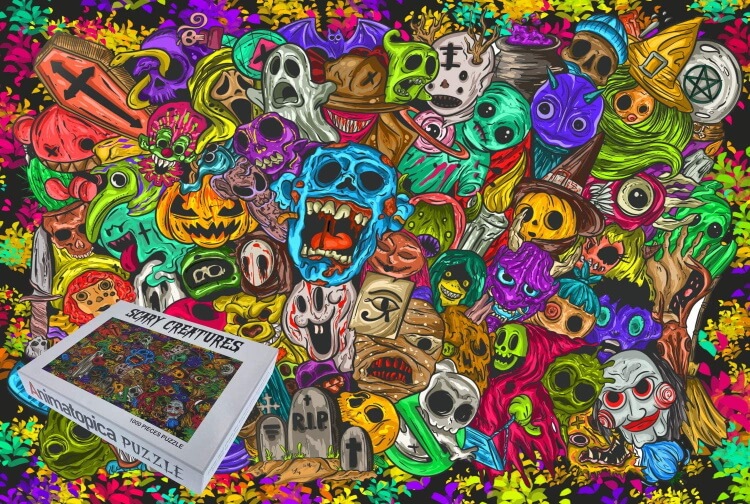Puzzles for Adults and Kids
Challenge yourself with an Animatopica 1000 piece puzzles for adults and kids. Supercharge your brain as you enjoy putting together the pieces of our fine, unique puzzles that tell a story and are well-made. A 1000 piece puzzle provides just the perfect level of challenge, without taking forever to complete. That’s why it’s one of the most popular sizes when it comes to puzzles.
Here’s why you’ll love Animatopica puzzles:
- Animatopica creates puzzles with unique concepts and themes that are fascinating and tell a story.
- Our artists deliver engaging art you will enjoy, usually in vibrant colors to soothe your senses. Or captivating images.
- Our production steps are rigorous; from concept creation to art illustration to print production. We want you to have the best experience.


Our Scary Creatures Puzzle
You will enjoy Scary Creatures, our first puzzle. This jigsaw puzzle for adults and kids is a mix of everything:
- A captivating concept that shows unearthly, zombie-like ghouls, ghosts, phantoms, specters, spirits, creatures and monsters that are both scary and inviting.
- A lot of character in their faces too. You’ll find our creatures laughing, screaming, yelling, screeching, mocking, watching, staring, teeth-gnashing, smiling and pondering in wondrous ways.
- Some are garbed in appearances that look like Halloween costumes for men, women, boys and girls. The creatures look like scary monsters and apparitions emanating from haunted houses, that Halloween feeling that you pay to enjoy.
- A GREAT ADDITION TO YOUR COLLECTION.
How to Solve Jigsaw Puzzles
Jigsaw puzzles are for adults and kids and can be enjoyed by the family or with friends.
Your goal is to fill a frame with cut-out, oddly-shaped pieces so as to recreate the puzzle image displayed on the box. Puzzle images come in various forms. They can be famous paintings, characters, unique drawings or landmarks.
The difficulty of puzzles can vary, depending on the complexity of the image or the number of pieces included in the puzzle. For children, jigsaw puzzle pieces are much fewer and come in large, easy-to-fit pieces that make it not too daunting for kids. For adults, they can come in pieces that are up to a thousand or more, with much more complex images that may take days to fully solve.
Methods for Solving Jigsaw Puzzles
Different people have different approaches to putting puzzles together. Some start out by separating pieces based on color. They get a rough idea of which color group a piece belongs in by looking at the image.
A popular method that is also used is to start recreating at the margins. They isolate pieces with straight paths, as they are more likely to form the frame of the image.
Another way people start is by identifying and putting together the four corners first as a guide for setting up the edges of the frame. But don’t count on this, as not all puzzles come with pieces that have straight paths. Edges of some puzzles may contain irregular shapes to make it more challenging to put the margins together.
More about Jigsaw Puzzles
A jigsaw puzzle is a board game made up of tiles that involves assembling usually oddly shaped pieces that interlock. Usually, individual pieces have a slice of the image to be recreated. With the assembling of the individual pieces, a full picture of the jigsaw puzzle is completed.
Originally, the way jigsaw puzzles were created was to paint a picture on a piece of rectangular wood and then cut the painted picture into several small pieces. Although it was called a jigsaw, the wood was never cut using jigsaws. Strange, isn’t it?
A London engraver and cartographer, John Spilsbury, is credited as being the first to commercialize jigsaw puzzles, sometime around 1760. Today, jigsaw puzzles are made primarily using cardboard.
The type of images you will find on jigsaw puzzles depends on the creativity or imagination of their makers. They range from buildings to wildlife, nature, people, abstract art and anything images reflecting life. Sometimes they are images shot using a camera; at other times, they are the illustrations of artists.
Jigsaw Puzzle Sizes
Jigsaw puzzles come in different sizes. Smaller adult sizes may start at 300, 500, 750 piece puzzles. Adult sizes that are more sophisticated come in 1,000, 1,500, 2,000, 3,000, 4,000, 5,000, and 6,000 and even up to 40,000 pieces. Depending on the dexterity and commitment of the player, some puzzles can take anything between a day and multiple days to complete.
Jigsaw Puzzles by Age
Jigsaw puzzles targeted towards children often come with fewer, larger pieces. The goal is to enable them enjoy the puzzle, learn something and have a sense of accomplishment. For children that are very young, ideal puzzles may have 4 to 9 large pieces, so as to avoid a choking hazard. Puzzles for very young children are made of wood or plastic for durability and easy cleaning.
Adult jigsaw puzzles of course come with multiple, relatively smaller pieces that may number in the thousands. For a 1000 piece puzzle, a common layout may be 38 pieces by 27 pieces, which totals to 1,026 pieces. Many 500 piece puzzles come as 27 pieces by 19 pieces. Note that just because they are called adult pieces does not mean that some children cannot handle them. Many manufacturers prescribe their adult pieces for ages 12 years old and above.
“Family Puzzles” is another type of jigsaw puzzles. This is a hybrid puzzle in terms of size of pieces. The pieces come in 3 different sizes, from small to large. The goal is to enable family members of different ages, who have different hand sizes and skill levels, to enjoy family time together working on the a puzzle at the same time. These puzzles usually include 100 to 550 pieces.
Jigsaw Puzzle Types
Don’t assume that jigsaw puzzles are always flat and printed on cardboards. Besides flat or two dimensional puzzles, there are also three-dimensional puzzles that may be spherical jigsaws or pieces and parts for architectural recreations or the recreations of other objects.
Flat, two-dimensional jigsaw puzzles usually come in square, rectangular or round shapes. Depending on the shape, the edges may be straight or curved. Sometimes they could be irregular, to make them more challenging. Sometimes too, the shape of the entire puzzle itself may be the figure of an object or an animal – like a cut-out figure. The pieces of the edges in such cases vary, depending on the image.

